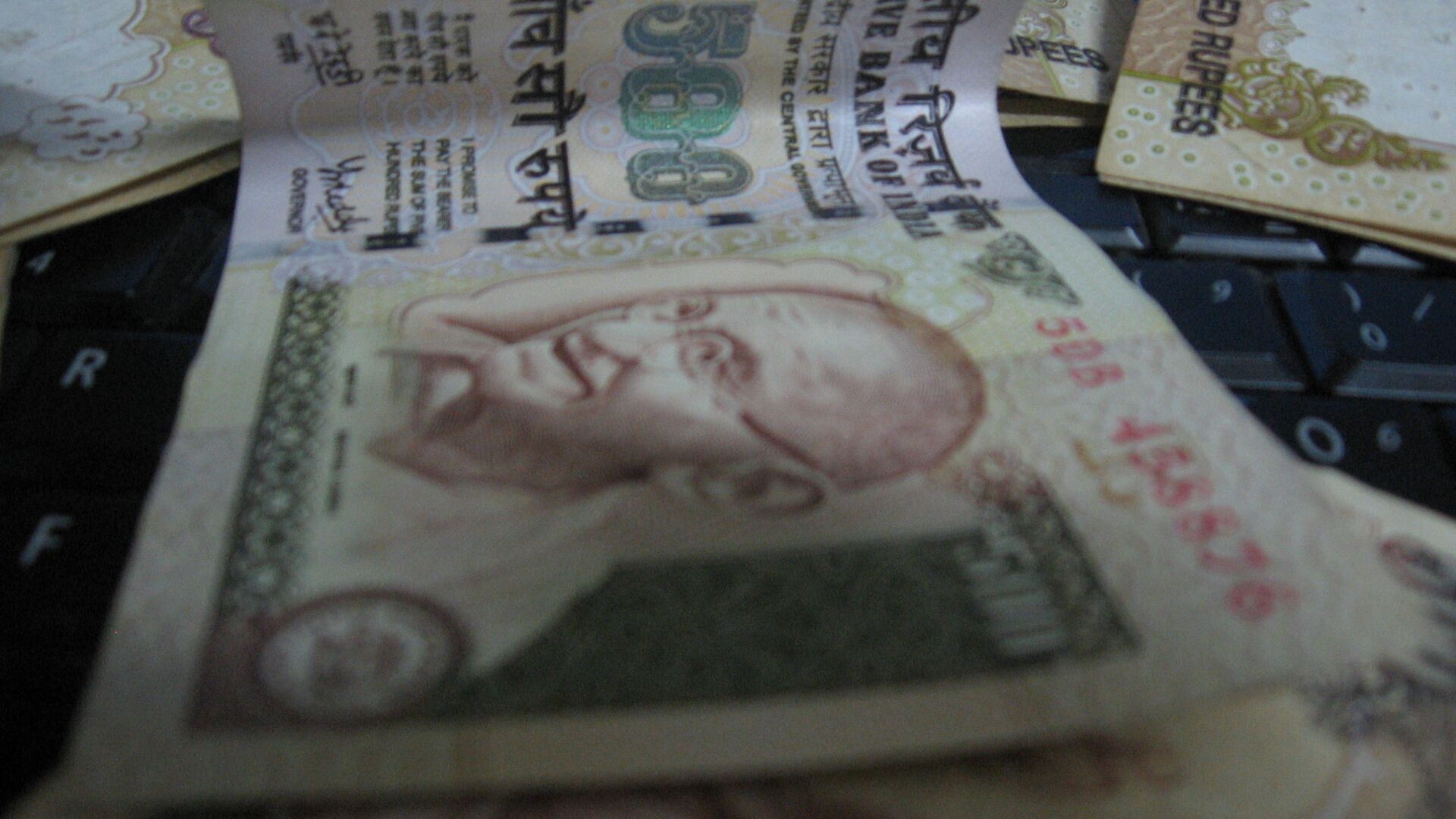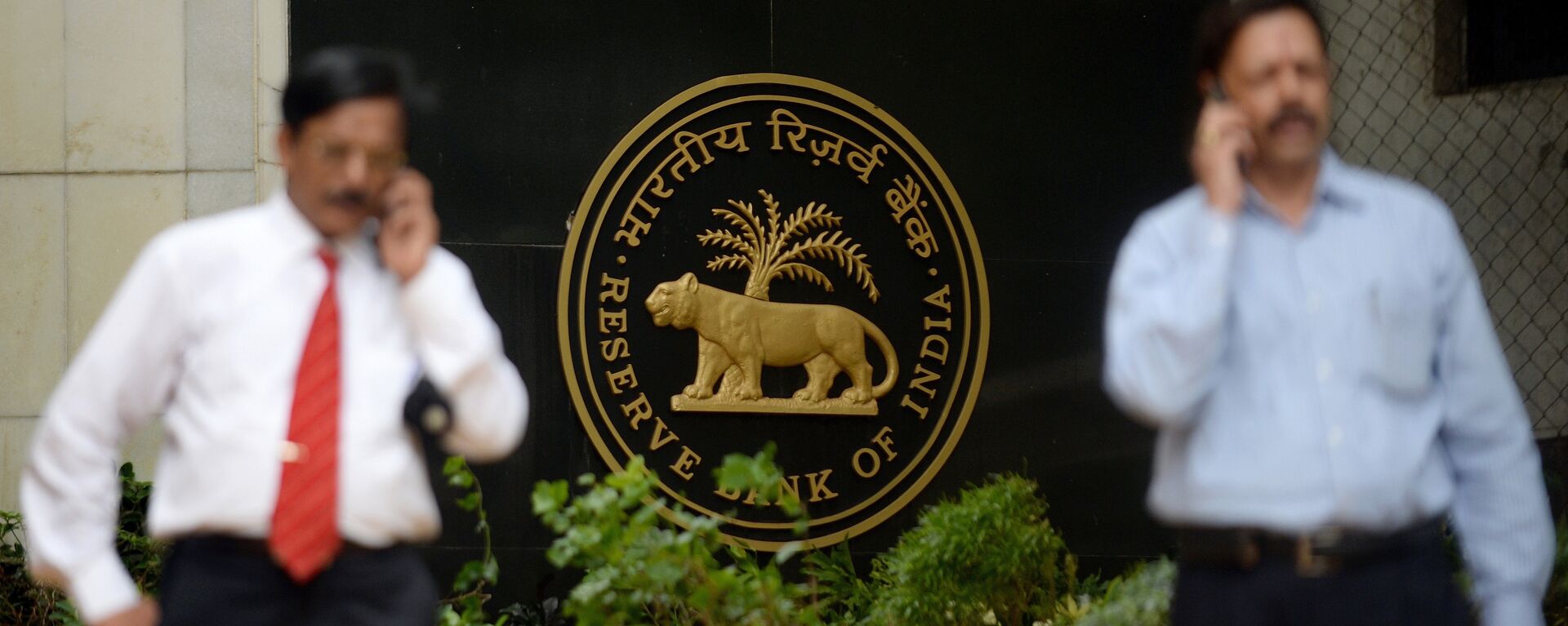https://sputnikglobe.com/20220702/external-factors-behind-rupee-depreciation-as-indian-economy-remains-strong-experts-say-1096870968.html
External Factors Behind Rupee Depreciation as Indian Economy Remains Strong, Experts Say
External Factors Behind Rupee Depreciation as Indian Economy Remains Strong, Experts Say
Sputnik International
Delhi has increased duty on gold imports and oil exports as the value of the rupee plunged to its lowest level against the US dollar on Friday. High commodity... 02.07.2022, Sputnik International
2022-07-02T04:00+0000
2022-07-02T04:00+0000
2023-03-05T11:22+0000
us
recession
indian ministry of finance
narendra modi
rupee
sputnik
ukraine
reserve bank of india
dollar
inflation
https://cdn1.img.sputnikglobe.com/img/19320/15/193201508_0:192:2048:1344_1920x0_80_0_0_4fe1bc181371bb39ee6ed5ac304ea3f1.jpg
Economists have advised the Reserve Bank of India (RBI) and the Indian government to allow the exchange rate to depreciate smoothly rather than stalling it artificially after the Indian rupee reached new lows this week.The experts claim that India's macroeconomic fundamentals remain strong amid unprecedented inflation that is engulfing major economies.Professor N. R. Bhanumurthy, an economist and vice-chancellor of Dr. B.R. Ambedkar School of Economics University (BASE), blamed "open-economy macroeconomic issues" for the recent fall in the value of the Indian rupee against the US dollar. The rupee hit an all-time low on Friday, selling as low as 79.11 against the USD.As the US inflation rate jumped to nearly a four-decade high, the Federal Reserve took an aggressive stance during the last FOMC meeting and raised interest rates by 75 basis points.The higher returns on investment in the US market prompted foreign investors to withdraw approximately $25.7 billion from Indian equities. The pace of withdrawal increased since April, when the Fed assumed a hawkish stance against inflation.The RBI data suggests that it spent approximately $18 billion between January and April to support the rupee against dollars. However, high commodity prices, including crude oil bills, pushed India's trade deficit to an all-time peak of $24 billion in May, meaning imports bill massively outpaced the country's exports. The Indian basket of crude oil prices rose to $117.20 per barrel in June from $73.30 per barrel in December 2021.The demand for dollars remains high as crude oil prices hover near $120 per barrel.The economist also underlined that the extent of rupee depreciation is "relatively less than the depreciation of other emerging market economies."The rupee has lost more than 6 percent this year, with the dollar index up by more than 9 percent against the euro and Japanese yen.In response to various reports suggesting India's balance of payments deficit may grow to $40 billion in 2022, compared to a surplus of $55 billion in 2021, the Finance Ministry has imposed an additional 5 percent import duty on gold to curb the demand of the yellow metal.Finance Minister Nirmala Sitharaman said "extraordinary times" require such measures, including the imposition of a windfall tax on fuel exports.Silver LiningOn Thursday, RBI Governor Shaktikanta Das acknowledged that the Indian economy is facing significant spillovers from the evolving global conditions, but stressed that the "innate strength and resilience of our macro fundamentals is catalyzing a steady recovery."Bhanumurthy agreed with the RBI's observation, appreciating steps taken by the government and the Central Bank in the last few months."Domestic fundamentals are quite strong, especially due to well-managed fiscal and monetary policies. However, almost one-fourth of the growth depends on the external sector. Because of many global downside risks, that component of the growth could take a hit and might affect the overall growth," Bhanumurthy said.On Friday, Crisil, an Indian subsidiary of S&P Global, noted silver linings in the form of an uptick in contact-intensive services, higher tax collections, and the forecast of a normal and well-distributed monsoon."While higher tax collections are partly a result of higher inflation leading to higher nominal growth, they also reflect the healthy momentum observed in the first quarter of the current fiscal," CRISIL said.K. V. Subramanian, an economist and former chief economic advisor to the Indian government, advised foreign investors to treat India separately from other emerging markets.The former economic advisor said the Indian economy is gathering momentum, which can be seen in 18 percent growth in core sector output in May and an eight-month high in the Index of Industrial Production (7.1 percent) in April.Retail inflation also came in at 7.04 percent in May, easing from a near-eight-year high of 7.79 percent in April.Subramanian expects an increase in private investment when uncertainty due to Ukraine's conflict receded. ”Amidst global recession, India should grow approximately 7%," he added.India's economy grew 8.7 percent in the last year against a 6.6 percent contraction in 2020. Despite the global headwind, RBI retained its GDP growth forecast at 7.2 percent this year.Despite falling $50 billion from the peak of $640 billion in September 2021, India's foreign exchange reserves are still enough to cover about 10 months of imports.The data released by RBI on Friday showed that forex reserves erased a three-week declining spree and climbed by $2.734 billion to $593.323 billion on 24 June 2022.Many analysts predict the return of foreign portfolio investors in the medium term, given the upward movement predicted in GDP growth next year compared to downward revision by other countries.
https://sputnikglobe.com/20220408/ukrainian-crisis-hits-indias-economy-as-rbi-projects-lower-growth-and-higher-inflation-1094580072.html
ukraine
Sputnik International
feedback@sputniknews.com
+74956456601
MIA „Rosiya Segodnya“
2022
Rishikesh Kumar
https://cdn1.img.sputnikglobe.com/img/07e4/08/04/1080055820_0:0:388:389_100x100_80_0_0_40018ee210946d65d49ffba4f4c008e1.jpg
Rishikesh Kumar
https://cdn1.img.sputnikglobe.com/img/07e4/08/04/1080055820_0:0:388:389_100x100_80_0_0_40018ee210946d65d49ffba4f4c008e1.jpg
News
en_EN
Sputnik International
feedback@sputniknews.com
+74956456601
MIA „Rosiya Segodnya“
Sputnik International
feedback@sputniknews.com
+74956456601
MIA „Rosiya Segodnya“
Rishikesh Kumar
https://cdn1.img.sputnikglobe.com/img/07e4/08/04/1080055820_0:0:388:389_100x100_80_0_0_40018ee210946d65d49ffba4f4c008e1.jpg
us, recession, indian ministry of finance, narendra modi, rupee, sputnik, ukraine, reserve bank of india, dollar, inflation
us, recession, indian ministry of finance, narendra modi, rupee, sputnik, ukraine, reserve bank of india, dollar, inflation
External Factors Behind Rupee Depreciation as Indian Economy Remains Strong, Experts Say
04:00 GMT 02.07.2022 (Updated: 11:22 GMT 05.03.2023) Delhi has increased duty on gold imports and oil exports as the value of the rupee plunged to its lowest level against the US dollar on Friday. High commodity prices on the global market have had a domino effect, putting pressure on the revenue deficit with a rise in import bills.
Economists have advised the Reserve Bank of India (RBI) and the Indian government to allow the exchange rate to depreciate smoothly rather than stalling it artificially after the Indian rupee reached new lows this week.
The experts claim that India's macroeconomic fundamentals remain strong amid
unprecedented inflation that is engulfing major economies.
Professor N. R. Bhanumurthy, an economist and vice-chancellor of Dr. B.R. Ambedkar School of Economics University (BASE), blamed "open-economy macroeconomic issues" for the recent fall in the value of the Indian rupee against the US dollar. The rupee hit an all-time low on Friday, selling as low as 79.11 against the USD.
"Rupee depreciation is largely due to open-economy macroeconomic issues such as [a] sharp increase in US interest rates (leading to the outflow of foreign capital), widening current account deficit due to higher world oil prices as well as expected decline in exports, and also due to rising inflationary pressures in India," Bhanumurthy told Sputnik.
As the US inflation rate jumped to nearly a four-decade high, the Federal Reserve took an aggressive stance during the last FOMC meeting and raised interest rates by 75 basis points.
The higher returns on investment in the US market prompted foreign investors to withdraw approximately
$25.7 billion from Indian equities. The pace of withdrawal increased since April, when the Fed assumed a hawkish stance against inflation.
The RBI data suggests that it spent approximately $18 billion between January and April to support the rupee against dollars. However, high commodity prices, including crude oil bills, pushed India's trade deficit to an all-time peak of $24 billion in May, meaning imports bill massively outpaced the country's exports. The Indian basket of crude oil prices rose to $117.20 per barrel in June from $73.30 per barrel in December 2021.
The demand for dollars remains high as crude oil prices hover near $120 per barrel.
Upon asking about ways to halt the dollar's demand, Bhanumurthy explained, "This may be managed through two ways: allowing the exchange rate to depreciate smoothly and allow the foreign exchange reserves to decline. India is well cushioned with nearly $600 billion reserves, which can smoothen the volatility in the forex market."
The economist also underlined that the extent of rupee depreciation is "relatively less than the depreciation of other emerging market economies."
The rupee has lost more than 6 percent this year, with the dollar index up by more than 9 percent against the euro and Japanese yen.
In response to various reports suggesting India's balance of payments deficit may grow to $40 billion in 2022, compared to a surplus of $55 billion in 2021, the Finance Ministry has imposed an additional 5 percent import duty on gold to curb the demand of the yellow metal.
Finance Minister Nirmala Sitharaman said "extraordinary times" require such measures, including the imposition of a
windfall tax on fuel exports.On Thursday, RBI Governor Shaktikanta Das acknowledged that the Indian economy is facing significant spillovers from the evolving global conditions, but stressed that the "innate strength and resilience of our macro fundamentals is catalyzing a steady recovery."
Bhanumurthy agreed with the RBI's observation, appreciating steps taken by the government and the Central Bank in the last few months.
"Domestic fundamentals are quite strong, especially due to well-managed fiscal and monetary policies. However, almost one-fourth of the growth depends on the external sector. Because of many global downside risks, that component of the growth could take a hit and might affect the overall growth," Bhanumurthy said.
On Friday, Crisil, an Indian subsidiary of S&P Global, noted silver linings in the form of an uptick in contact-intensive services, higher tax collections, and the forecast of a normal and well-distributed monsoon.
"While higher tax collections are partly a result of higher inflation leading to higher nominal growth, they also reflect the healthy momentum observed in the first quarter of the current fiscal," CRISIL said.
K. V. Subramanian, an economist and former chief economic advisor to the Indian government, advised foreign investors to treat India separately from other emerging markets.
"India's macroeconomics is fundamentally better than emerging market economies because of sound economic policy. So, treat India as positively different from other emerging economies," Subramanian reckoned.
The former economic advisor said the Indian economy is gathering momentum, which can be seen in 18 percent growth in core sector output in May and an eight-month high in the Index of Industrial Production (7.1 percent) in April.
Retail inflation also came in at 7.04 percent in May, easing from a near-eight-year high of 7.79 percent in April.
Subramanian expects an increase in private investment when uncertainty due to Ukraine's conflict receded. ”Amidst global recession, India should grow approximately 7%," he added.
India's economy grew 8.7 percent in the last year against a 6.6 percent contraction in 2020. Despite the global headwind, RBI retained its GDP growth forecast at 7.2 percent this year.
Despite falling $50 billion from the peak of $640 billion in September 2021, India's foreign exchange reserves are still enough to cover about 10 months of imports.
The data released by RBI on Friday showed that forex reserves erased a three-week declining spree and climbed by $2.734 billion to $593.323 billion on 24 June 2022.
Many analysts predict the return of foreign portfolio investors in the medium term, given the upward movement predicted in GDP growth next year compared to downward revision by other countries.





